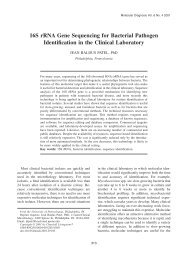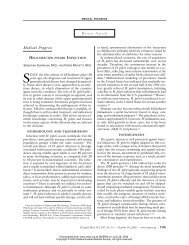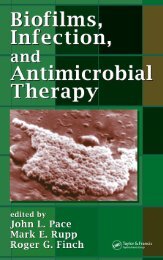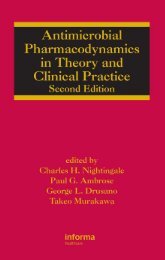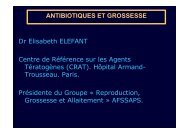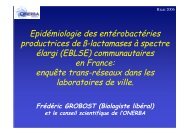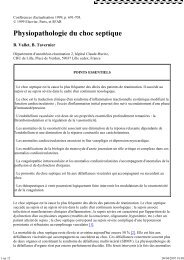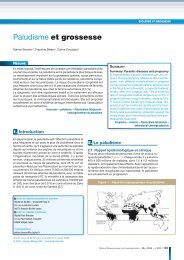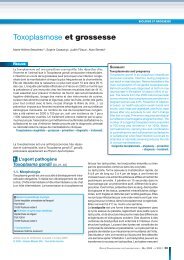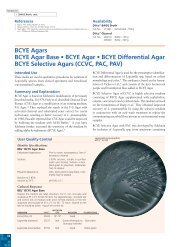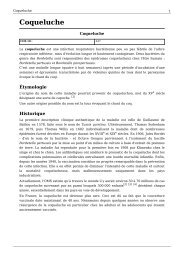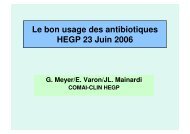Principles and Practice of Clinical Bacteriology Second Edition - Free
Principles and Practice of Clinical Bacteriology Second Edition - Free
Principles and Practice of Clinical Bacteriology Second Edition - Free
Create successful ePaper yourself
Turn your PDF publications into a flip-book with our unique Google optimized e-Paper software.
30 ORAL AND OTHER NON-β-HAEMOLYTIC STREPTOCOCCI<br />
process has reached the periapical region, infection either may remain<br />
localized as an acute dental abscess or as a chronic granuloma or may<br />
spread more widely in various directions depending on its anatomical<br />
position. In some cases such spreading infections may cause a lifethreatening<br />
situation, for example, if the airway is obstructed by<br />
subm<strong>and</strong>ibular swelling (Ludwig’s angina).<br />
The disease is initiated by acid demineralization <strong>of</strong> the teeth<br />
because <strong>of</strong> the metabolic activities <strong>of</strong> saccharolytic bacteria, including<br />
streptococci, which are situated on the tooth surface as part <strong>of</strong> the<br />
complex microbial community known as dental plaque. Dental plaque<br />
accumulates rapidly on exposed tooth surfaces in the mouth <strong>and</strong><br />
consists <strong>of</strong> a complex mixture <strong>of</strong> bacteria <strong>and</strong> their products. Many <strong>of</strong><br />
the oral streptococci listed in Table 2.1 are prominent components <strong>of</strong><br />
dental plaque. When an external source <strong>of</strong> carbohydrate becomes<br />
available, in the form <strong>of</strong> dietary carbohydrate (particularly sucrose),<br />
streptococci <strong>and</strong> other plaque bacteria rapidly utilize the fermentable<br />
sugars <strong>and</strong> release acidic metabolic end products such as lactic acid.<br />
This can result in a rapid drop in pH in the vicinity <strong>of</strong> teeth that, if<br />
sufficiently low (pH 5.5 or less), in turn results in the demineralization<br />
<strong>of</strong> the dental enamel.<br />
Most detailed studies on the pathogenesis <strong>of</strong> dental caries have<br />
focused on the mutans streptococci since these are widely regarded as<br />
the most significant initiators <strong>of</strong> the disease. Properties <strong>of</strong> these streptococci<br />
that are considered to be important in caries include ability to<br />
survive <strong>and</strong> grow at relatively low pH, production <strong>of</strong> extracellular<br />
polysaccharides from glucose <strong>and</strong> production <strong>of</strong> acid from carbohydrates,<br />
<strong>and</strong> mutant strains lacking in one or more <strong>of</strong> these attributes<br />
have been shown to be less cariogenic in experimental animals<br />
(reviewed by Kuramitsu, 2003). The frequent consumption <strong>of</strong> sugar is<br />
proposed to shift the plaque population in favour <strong>of</strong> aciduric species<br />
able to grow <strong>and</strong> survive in low pH conditions, which in turn results in<br />
greater plaque acidification <strong>and</strong>, consequently, greater enamel dissolution<br />
(Marsh, 2003). However, oral species other than mutans group<br />
streptococci are thought to contribute to the disease process.<br />
The main approaches to caries prevention include the control <strong>of</strong><br />
dietary carbohydrates, particularly by reducing the frequency <strong>of</strong> sugar<br />
intakes, the use <strong>of</strong> fluorides (both topically <strong>and</strong> systemically), maintenance<br />
<strong>of</strong> good oral hygiene <strong>and</strong> plaque control, application <strong>of</strong> fissure<br />
sealants <strong>and</strong> regular dental check-ups. With a better underst<strong>and</strong>ing <strong>of</strong><br />
mucosal immunity <strong>and</strong> using new technologies available in molecular<br />
biology, researchers have developed novel caries preventative<br />
measures. These include local passive <strong>and</strong> active immunization,<br />
replacement therapy (the use <strong>of</strong> engineered noncariogenic S. mutans<br />
strains to replace cariogenic species within dental plaque) <strong>and</strong> the use<br />
<strong>of</strong> anti-adhesive peptides (Kelly et al., 1999; Hillman, 2002; Koga<br />
et al., 2002). Despite growing evidence from laboratory animal <strong>and</strong><br />
human clinical studies <strong>of</strong> the ability <strong>of</strong> these approaches to control<br />
S. mutans numbers, their potential as anti-caries treatments has yet to<br />
be fully realized.<br />
LABORATORY DIAGNOSIS<br />
Specimens <strong>and</strong> Growth Media<br />
Non-β-haemolytic streptococci are isolated from a wide range <strong>of</strong><br />
clinical specimens such as blood, pus, wounds, skin swabs <strong>and</strong> biopsies<br />
as well as from dental plaque, saliva <strong>and</strong> other oral sites. Obtaining<br />
pus from an oral abscess is best done by direct aspiration using a<br />
hypodermic syringe rather than by swabbing, to reduce the risk <strong>of</strong><br />
contaminating the sample with the oral flora, although in some<br />
instances (e.g. with infants), swab samples may be the only option<br />
available, unless the patient is undergoing a general anaesthesia.<br />
When sampling oral sites for ecological studies, it is necessary to<br />
ensure that the area sampled is small enough to be representative <strong>of</strong><br />
a discrete site to avoid the risk <strong>of</strong> obscuring the differences between<br />
sites by sampling too big an area.<br />
Where the laboratory processing <strong>of</strong> a specimen may be delayed, the<br />
clinical sample is best held in a suitable reduced transport fluid such<br />
as the one described by Hardie <strong>and</strong> Whiley (1992).<br />
The non-β-haemolytic streptococci are fastidious organisms, with a<br />
need for a carbohydrate source, amino acids, peptides <strong>and</strong> proteins, fatty<br />
acids, vitamins, purines <strong>and</strong> pyrimidines. These bacteria therefore need<br />
complex growth media commonly containing meat extract, peptone <strong>and</strong><br />
blood or serum. Non-β-haemolytic streptococci are best isolated from<br />
clinical samples on a combination <strong>of</strong> nonselective <strong>and</strong> selective agar<br />
media. Nonselective examples include blood agar 2 (Oxoid, Hampshire,<br />
UK), Columbia agar (Gibco BRL, Life Technologies, Paisley, UK),<br />
fastidious anaerobic agar (Laboratory M, Amersham, UK) <strong>and</strong> brain–<br />
heart infusion agar (Oxoid) supplemented with 5% defibrinated horse or<br />
sheep blood. Several selective media are available for the non-β-haemolytic<br />
streptococci. The two most commonly used agars are trypticase–yeast–<br />
cystine (TYC) <strong>and</strong> mitis–salivarius (MS) agars that contain 5% sucrose<br />
to promote the production <strong>of</strong> extracellular polysaccharides, resulting in<br />
the production <strong>of</strong> characteristic colonial morphologies as an aid to identification.<br />
TYC is available commercially from Laboratory M; MS agar<br />
is available from Oxoid <strong>and</strong> from Difco (Detroit, MI, USA). Other<br />
selective media commonly used for the isolation <strong>of</strong> mutans streptococci<br />
are based on TYC or MS agars <strong>and</strong> have the addition <strong>of</strong> bacitracin<br />
(0.1–0.2 U/ml) <strong>and</strong> an increased amount <strong>of</strong> sucrose (20%). Nalidixic<br />
acid–sulphamethazine (NAS) agar is a selective medium for the anginosus<br />
group streptococci <strong>and</strong> uses 40 g/l <strong>of</strong> sensitivity agar supplemented with<br />
30 μg/ml <strong>of</strong> nalidixic acid, 1 mg/ml <strong>of</strong> sulphamethazine (4-amino-N-<br />
[4,6-dimethyl-2-pyrimidinyl]benzene sulphonamide) <strong>and</strong> 5% defibrinated<br />
horse blood. This medium is also selective for S. mutans.<br />
As streptococci are facultative anaerobes, incubation is best carried<br />
out routinely in an atmosphere <strong>of</strong> air plus 10% carbon dioxide or in an<br />
anaerobic gas mix containing nitrogen (70–80%), hydrogen (10–20%)<br />
<strong>and</strong> carbon dioxide (10–20%). Some strains have an absolute requirement<br />
for carbon dioxide, particularly on initial isolation. Colonies on blood<br />
agar are typically 1 mm or less in diameter after incubation for 24 h at<br />
37 °C, are nonpigmented <strong>and</strong> <strong>of</strong>ten appear translucent. On blood agar<br />
the streptococci discussed in this chapter usually produce α-haemolysis<br />
or are non-(γ)-haemolytic. However, as mentioned previously, the<br />
haemolytic reactions <strong>of</strong> different strains within a species may vary <strong>and</strong><br />
are sometimes influenced by the source <strong>of</strong> blood (e.g. horse, sheep) <strong>and</strong><br />
by the incubation conditions. Some examples <strong>of</strong> colonial morphology<br />
on different culture media are illustrated in Figure 2.4.<br />
Liquid culture <strong>of</strong> these streptococci may be carried out in a<br />
commercial broth such as Todd–Hewitt broth or brain–heart infusion<br />
broth (Oxoid) with or without supplementation with yeast extract<br />
(0.5%). The growth obtained in broth cultures varies from a diffuse<br />
turbidity to a granular appearance with clear supernatant depending on<br />
strain <strong>and</strong> species.<br />
Initial Screening Tests<br />
Streptococci are usually spherical, with cells <strong>of</strong> approximately 1-μm<br />
diameter arranged in chains or pairs. The length <strong>of</strong> the chains may vary<br />
from only a few cells to over 50 cells, depending on the strain <strong>and</strong><br />
cultural conditions (longer chains are produced when the organisms are<br />
grown in broth culture). Streptococci stain positive in the Gram stain,<br />
although older cultures may appear Gram variable. Some strains may<br />
appear as short rods under certain cultural conditions. Isolates should<br />
be tested for catalase reaction, <strong>and</strong> only catalase-negative strains<br />
should be put through further streptococcal identification tests.<br />
The clinical microbiologist should be aware that, because <strong>of</strong> developments<br />
in taxonomic studies, several other genera <strong>of</strong> facultative<br />
anaerobic Gram-positive cocci that grow in pairs or chains have been<br />
proposed that may superficially resemble streptococci. The scheme<br />
described in Table 2.8 should allow the differentiation <strong>of</strong> these genera<br />
on the basis <strong>of</strong> a few cultural <strong>and</strong> biochemical tests, with great caution<br />
to be exercised in the interpretation <strong>of</strong> morphological observations.




